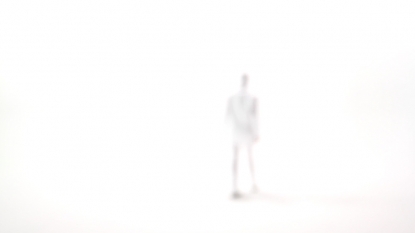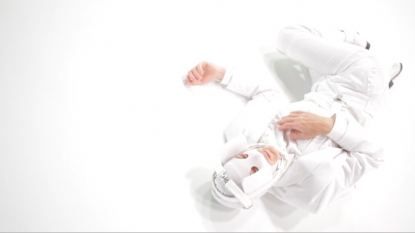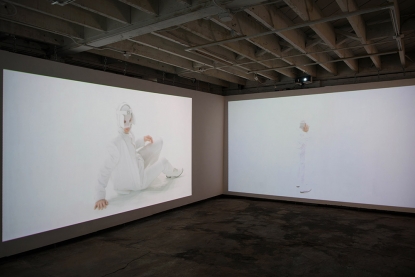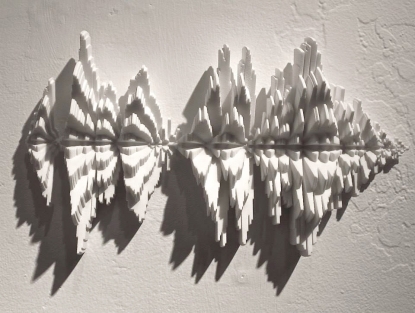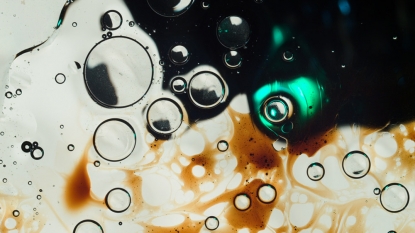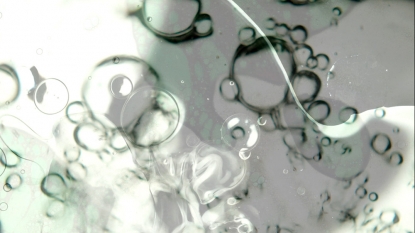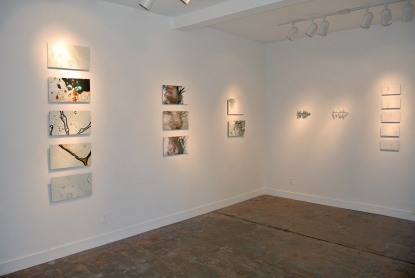Feature: Reviews
KADET KUHNE – The Way Through
- Krowswork
- Oakland, CA
- March 7 - April 12, 2014
There’s an old joke I’ve heard experimental musicians tell that holds some water – if you’re inclined to distinction and categorization, that is. It goes like this:
“What do noise musicians eventually become? Sound artists.”
The implication being drawn is that there’s a line between semi and fully realized work, a “big A” and “little a” art. In The Way Through, Kadet Kuhne effectively charts a path that allows a sound artist's vision to be realized palpably and materially; existing simultaneously on many planes and most manifestly being work that succeeds broadly as well as subtly.
As air can be a fluid whose shape is hardly seen, sound waves are shapes we hear rather than see. The effects of both leave lasting traces and are especially ripe territory for aesthetic interpretation.
With her Interference Series the terms “Perceived Limitations” and “Dependent Origination” are made matter in the form of 3D-printed sculptures which have been displayed on different sides, echoing the limits of perceptibility which the three-channel video Rebound in the main screening room offers.
Of the two terms, the latter provides a connective tissue which resonates throughout the rest of the work. It is the English translation of a Sanskit word “Pratītyasamutpāda” which Buddhist monk and author Thích Nhất Hạnh has described as the concept that “...everything is a result of multiple causes and conditions...” My loose reading is this: we are as others see us and as we present ourselves and cannot know all the ingredients that make up the mix that is us. As Slavoj Zizek has noted, “Words are never 'only words'; they matter because they define the contours of what we can do.”
In Kuhne's three-channel Rebound, an androgynous all white clad performer begins a journey fraught by pratfalls, no doubt partially the result of the horse-blinders which limit his/her's field of vision. I note the gender ambiguity here as it is central to the narrative – one need not now pick up on the reference to androgynous fashion popular in the Weimar-era gay culture, it is abundantly clear that we are witnessing a figure at a crux as gender and time have become fluid. A dilation occurs shifting the sequence back and forth, ever choppier or less so – depending on which screen you find yourself viewing at any given moment. It was originally screened as single-channel work and having seen only this version I could not imagine it working to such great effect in any other fashion.
Noted physicist Richard Feynman in conversation with the artist Jirayr Zorthian once argued that one who sees as supreme the aesthetic sense is missing out on the full picture, saying,
“...I could imagine the cells in there, the complicated actions inside, which also have a beauty. I mean it's not just beauty at this dimension, at one centimeter; there's also beauty at smaller dimensions, the inner structure, also the processes. The fact that the colors in the flower evolved in order to attract insects to pollinate it is interesting; it means that insects can see the color.”
A similar notion is at play in Quantum Tunneling, a single-channel video digitally filmed in large format with sound which effectively employs oil and waters as active ingredients in ever moving whole – natural processes actively at work. At this macro scale, one cannot help but get a sense of agitation, of palpable energy – even in the 2D and lenticular stills of the video work from this series.
In the middle screening room, Emerge, a circular motion-activated ceiling projection provides a parallel to Rebound in that one's position relative to the projection changes the piece completely and for it to be completed, one must pass below it. Monochrome water floods an ocular expanse, tears perhaps or an echo of natural forms seen in macro or given unseen shape elsewhere in the exhibition. On multiple visits, I noticed that people seemed to spend the longest viewing time with this piece and Rebound. With Rebound, such a response is necessary to get the full effect. Here though, on repeat viewing, what I saw was a hybrid of Rothko's chapel and the sometimes unexpected majesty at work in nature: a place for reflection of the refraction given our ever changing identities as seen through the eyes of another.

